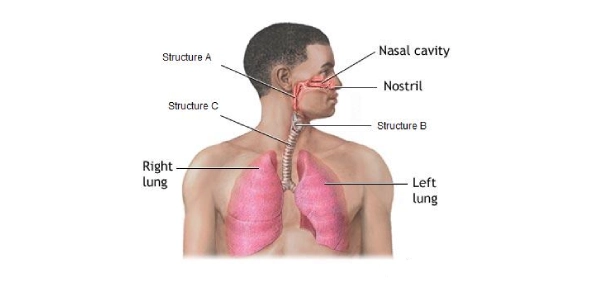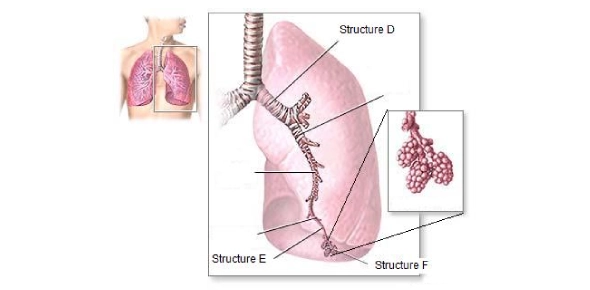Respiration - Human Gaseous Exchange

Choose the best suitable answer for the following questions(15marks)
- 1.
Name Structure A, B & C Diagram 1: Overview of Respiratory System
- A.
Trachea, Larynx, Bronchus
- B.
Larynx, Trachea, Pharynx
- C.
Pharynx, Larynx, Trachea
- D.
Trachea, Larynx, Pharynx
Correct Answer
C. Pharynx, Larynx, TracheaExplanation
The correct answer is Pharynx, Larynx, Trachea. This is the correct order of the structures in the respiratory system. Air enters the respiratory system through the pharynx, then passes through the larynx, and finally enters the trachea.Rate this question:
-
- 2.
Name Structure D and E Diagram 2: The Left Lung
- A.
Bronchiole, Bronchi
- B.
Alveoli, Bronchus
- C.
Bronchi, Bronchiole
- D.
Bronchus, Bronchiole
Correct Answer
D. Bronchus, BronchioleExplanation
The given answer, "Bronchus, Bronchiole," is correct because it follows the logical structure of the respiratory system. The bronchus is a larger airway that branches off from the trachea and leads into the lungs. From the bronchus, smaller airways called bronchioles branch out. Therefore, the bronchus comes before the bronchiole in the respiratory system's hierarchy.Rate this question:
-
- 3.
Structure F is well adapted for its function of ___________________.
- A.
Aerobic Respiration
- B.
Gaseous Exchange
- C.
Anaerobic respiration
- D.
Inhalation
Correct Answer
B. Gaseous ExchangeExplanation
Structure F is well adapted for its function of gaseous exchange. Gaseous exchange refers to the process of exchanging oxygen and carbon dioxide between an organism and its environment. Structure F is likely to possess characteristics such as a large surface area, thin walls, and a rich blood supply, which are all adaptations that facilitate efficient gas exchange.Rate this question:
-
- 4.
Movement of air in and out of the lungs is due to ______________.
- A.
Diaphragm contracts and flattens
- B.
Inhalation & Exhalation
- C.
Difference in pressure
- D.
External intercostal muscles contract and internal intercostal muscles relax
Correct Answer
C. Difference in pressureExplanation
The movement of air in and out of the lungs is due to the difference in pressure. When the diaphragm contracts and flattens, and the external intercostal muscles contract while the internal intercostal muscles relax, the volume of the thoracic cavity increases. This decrease in pressure within the lungs causes air to rush in during inhalation. Conversely, when the diaphragm and intercostal muscles relax, the volume of the thoracic cavity decreases, increasing the pressure within the lungs and causing air to be expelled during exhalation.Rate this question:
-
- 5.
Which of the following statements is TRUE
- A.
Only diaphragm, intercostal muscles and sternum, is involved in inhalation and exhalation
- B.
During inhalation, external intercostal muscles relax and internal intercostal muscles contract.
- C.
Sternum move upward and forward exhalation.
- D.
Changes of the volume of cavity are workings of only the intercostal muscles and diaphragm.
Correct Answer
D. Changes of the volume of cavity are workings of only the intercostal muscles and diaphragm. -
- 6.
Which of the following statements is FALSE
- A.
C-shaped rings of cartilage are specialized structures of the trachea
- B.
Glands cells secreting mucus help trap dust particle in the trachea
- C.
Cilia in the trachea helps in breathing, to sweep air into the lungs and
- D.
Heart is found in the thoracic cavity
Correct Answer
C. Cilia in the trachea helps in breathing, to sweep air into the lungs andExplanation
The statement "Cilia in the trachea helps in breathing, to sweep air into the lungs" is false. Cilia in the trachea actually helps in the movement of mucus and trapped particles out of the respiratory system, not in sweeping air into the lungs. The correct function of cilia in the trachea is to remove foreign particles and mucus from the airways, preventing them from reaching the lungs.Rate this question:
-
- 7.
Concentration of oxygen is __________ in the lungs and __________ in the tissues.
- A.
High, low
- B.
Low, high
- C.
High, high
- D.
Low, low
Correct Answer
A. High, lowExplanation
The concentration of oxygen is high in the lungs because oxygen is inhaled and enters the bloodstream through the alveoli. From there, it is transported to the tissues where it is utilized in cellular respiration. In the tissues, the concentration of oxygen is low because it is constantly being consumed by cells for energy production. Therefore, the correct answer is high, low.Rate this question:
-
- 8.
CO2 + H2O H2CO3H+ + HCO3-The reaction above take place in the red blood cell. Infer what happens when the red blood cell is in an area of high concentration of CO2
- A.
The reaction move to the right
- B.
The reaction move to the left
- C.
The reaction remains unchanged
- D.
The red blood cell shrink
Correct Answer
A. The reaction move to the rightExplanation
In an area of high concentration of CO2, the reaction will move to the right. This means that more H2CO3H+ and HCO3- will be formed from the CO2 and H2O. This is because the increased concentration of CO2 will drive the reaction towards the products to establish equilibrium. As a result, the concentration of H2CO3H+ and HCO3- will increase, leading to a shift in the reaction towards the right side. This helps the red blood cell to effectively transport and remove CO2 from the body.Rate this question:
-
- 9.
From the equation CO2 + H2O H2CO3H+ + HCO3- ____________ is the enzyme which catalyze the formation of _______________.
- A.
Carbonic catalase, carbonic acid
- B.
Carbonic anhydrase, carbonic acid
- C.
Carbonic catalase, hydrogencarbonate ions
- D.
Carbonic anhydrase, hydrogencarbonate ions
Correct Answer
B. Carbonic anhydrase, carbonic acidExplanation
Carbonic anhydrase is the enzyme that catalyzes the formation of carbonic acid.Rate this question:
-
- 10.
Which of the following does not describe the adaptations of a Red Blood Cell?
- A.
Biconcave shape
- B.
One cell thick
- C.
Contains haemoglobin
- D.
Have an iron-containing structure
Correct Answer
B. One cell thickExplanation
The given answer, "One cell thick," does not describe the adaptations of a Red Blood Cell. Red Blood Cells are known for their biconcave shape, which allows for increased surface area and flexibility. They also contain haemoglobin, a protein that binds to oxygen and carries it throughout the body. Additionally, Red Blood Cells have an iron-containing structure called heme, which is essential for oxygen transport. However, being "one cell thick" is not a characteristic or adaptation specific to Red Blood Cells.Rate this question:
-
- 11.
Which of the following statements is FALSE
- A.
Alveoli is well supplied with blood capillaries.
- B.
Alveoli walls is one cell thick which increase the rate of diffusion of gases.
- C.
A thin film of moisture covering the surface of the alveolus allows membranes to slide over each other easily during breathing.
- D.
Numerous alveoli help increase surface area to volume ratio facilitates exchange of gases.
Correct Answer
C. A thin film of moisture covering the surface of the alveolus allows membranes to slide over each other easily during breathing.Explanation
The false statement is that a thin film of moisture covering the surface of the alveolus allows membranes to slide over each other easily during breathing.Rate this question:
-
- 12.
What are the common effects of Emphysema and Chronic bronchitis?
- A.
Surface area for gaseous exchange decreases
- B.
Excessive mucus is secreted by the epithelium
- C.
Airway block making breathing difficult
- D.
None of the above
Correct Answer
D. None of the aboveExplanation
The common effects of Emphysema and Chronic bronchitis are not listed in the given options. Both conditions are types of chronic obstructive pulmonary disease (COPD) and share some similar symptoms such as shortness of breath, coughing, and wheezing. Emphysema is characterized by damage to the air sacs in the lungs, leading to a decrease in the surface area available for gas exchange. Chronic bronchitis involves inflammation and excessive mucus production in the airways, leading to narrowing and blockage of the air passages. These effects were not mentioned in the given options.Rate this question:
-
- 13.
Carbon monoxide is a chemical found in tobacco smoke. It is known to reduce the efficiency of transportation of oxygen in the red blood cell. 'Infer, which structure is affected by carbon monoxide in red blood cell.
- A.
Shape
- B.
Nucleus
- C.
Haemoglobin
- D.
Thin walls
Correct Answer
C. HaemoglobinExplanation
Carbon monoxide binds to hemoglobin in red blood cells, forming a stable compound called carboxyhemoglobin. This binding is much stronger than the binding of oxygen to hemoglobin, so when carbon monoxide is present, it displaces oxygen from hemoglobin and reduces the amount of oxygen that can be transported throughout the body. This leads to a decrease in the efficiency of oxygen transportation, which can have serious health consequences. Therefore, the structure affected by carbon monoxide in red blood cells is hemoglobin.Rate this question:
-
- 14.
Analyze the experimental setup below.What is the experiment investigating?
- A.
The amount of oxygen in inspired air different from expired air
- B.
The water content in inspired air different from expired air
- C.
Is temperature of inspired air different from expired air
- D.
The amount of carbon dioxide in inspired air different from expired air
Correct Answer
D. The amount of carbon dioxide in inspired air different from expired airExplanation
The experimental setup is investigating whether the amount of carbon dioxide in inspired air is different from expired air. This can be determined by measuring the levels of carbon dioxide in both the inspired and expired air samples. By comparing these levels, the experiment aims to determine if there is a difference in the amount of carbon dioxide present in the two types of air.Rate this question:
-
- 15.
Which of the following statements is TRUE
- A.
Tar is a additive drug found in tobacco.
- B.
Number of cigarettes smoked per day is indirectly proportional with the risk of lung cancer
- C.
Carbon monoxide in tobacco increase the risk of fatty deposits in walls of arteries.
- D.
None of the above
Correct Answer
C. Carbon monoxide in tobacco increase the risk of fatty deposits in walls of arteries.Explanation
Carbon monoxide in tobacco increases the risk of fatty deposits in the walls of arteries. This is because carbon monoxide reduces the amount of oxygen in the blood, leading to the formation of plaque in the arteries. Plaque buildup can restrict blood flow and increase the risk of heart disease and other cardiovascular problems.Rate this question:
-
Quiz Review Timeline +
Our quizzes are rigorously reviewed, monitored and continuously updated by our expert board to maintain accuracy, relevance, and timeliness.
-
Current Version
-
Sep 29, 2023Quiz Edited by
ProProfs Editorial Team -
Oct 10, 2009Quiz Created by
Jeline
 Back to top
Back to top






